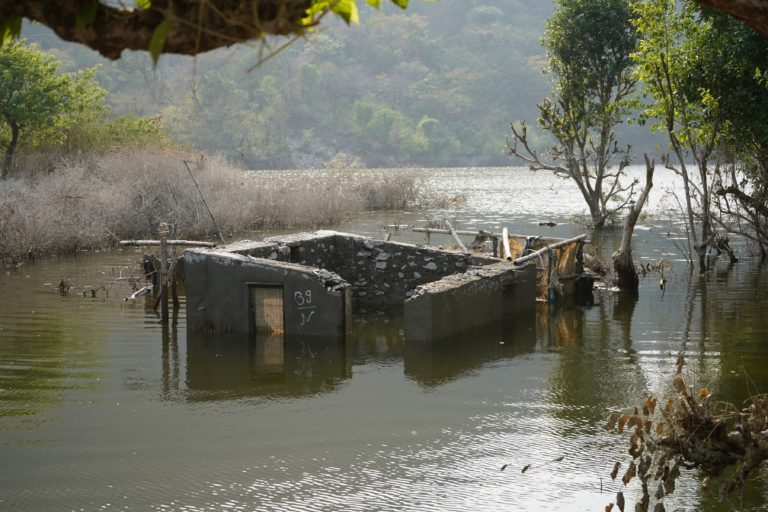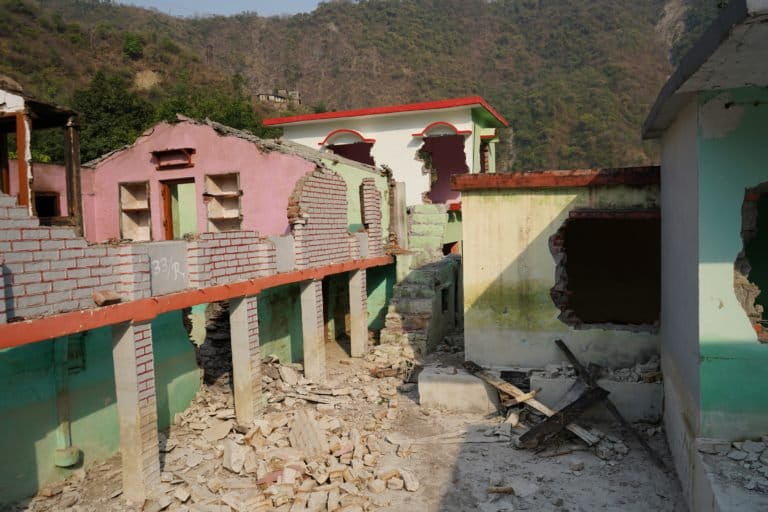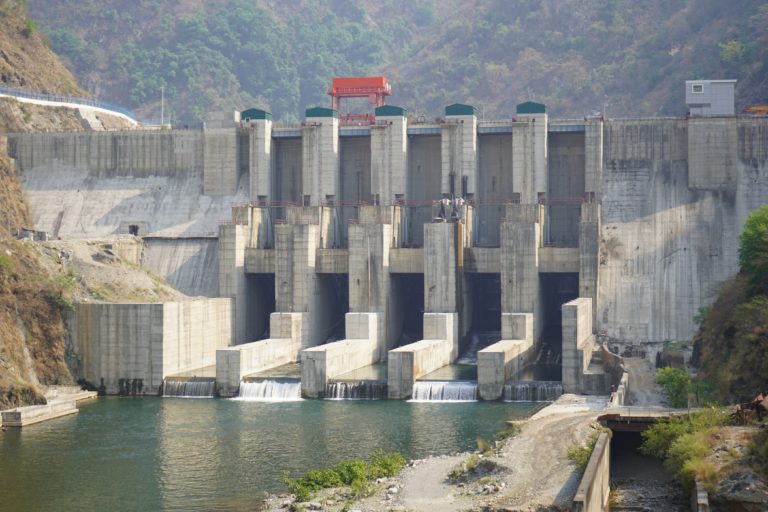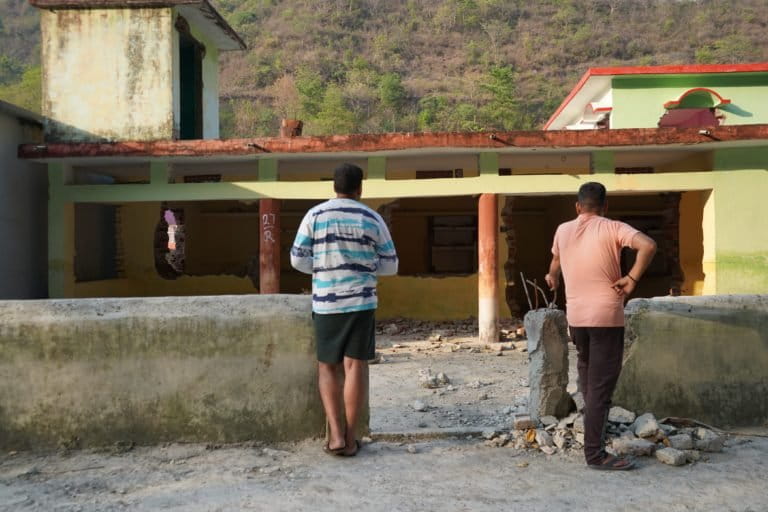- A month ago, Lohari village in Uttarakhand was submerged in the waters of the reservoir built as part of the upcoming Vyasi hydropower project.
- While monetary compensation is offered to the village residents, they are demanding land in return for land that has been taken for the project. The village residents primarily depend on farming and livestock rearing for their livelihood.
- The hydropower project is expected to be crucial for electricity generation. However, the residents claim that while this electricity is supplied to cities, there is no concern for people who have lost their homes and livelihood in places where the dams are in fact built.
Sukhpal Singh Tomar, 53, a resident of Lohari village in Uttarakhand and a teacher by profession, narrates the incident that led to the the loss of his home. “It will be nearly a month after the submergence of the village, but the villagers could not forget what happened to them. Our village is a tribal village and it is said that our village was home to Pandavas (Hindu mythological characters). Even today, we follow Pandavas traditions.”
Around a month ago, on April 11 in Lohari village, home to indigenous communities of Uttarakhand’s Jaunsar-Bawar region, homes, farmlands and cowsheds were submerged in the waters of the reservoir built as part of the Vyasi hydropower project. The 120-megawatt Vyasi Hydroelectric Project proposed to be constructed in Dehradun district of the hill state is part of the 420 MW Lakhwar-Vyasi project, the biggest hydroelectric dam complex on the Yamuna River and will address electricity requirements. The project with a proposed installation of 120 MW is expected to generate an annual energy generation of 375.22 MU in a 90% dependable year.

“I have spent my entire childhood in the village. I have seen my children growing up here. I have performed my husband’s last rites here,” said an emotional 95-year-old Gumani Devi, a resident of the village in the Vikas Nagar area of Uttarakhand.
A total of six villages were to be submerged by the project. One of the villages on the bank of Yamuna is Lohari, which has 77 families. On April 9, the residents of Lohari were served 48 hours or two days’ notice to evict their village and find a suitable place to live.
Rajesh Kumar, District Magistrate, Dehradun, told Mongabay-India. He added that the villagers knew months ago that their village will be submerged and they held several rounds of talks with the people to reach a consensus.
Rajpal Singh Tomar, 35, a farmer of Lohari, said, “Several meetings did take place, but no consensus was reached. We were not willing to give our land to get submerged. We protested and organised a peaceful dharna (sit-in protest) for four months to save our lands. From June 5 to October 2, a dharna was organised.”
“On October 2, the police put us (protestors) in jail. Our major demands were rehabilitation and compensation in the form of land for land. Neither was accepted, instead, we were arrested. Then we decided to not give our land to the government. But now, they took it forcefully and submerged it.”
DM Rajesh Kumar, however, said that the authorities have been figuring out a suitable area to resettle the people. He also added that the villagers have been compensated enough for their land.

In the 48 hours that the residents were given to evict the village, they had to move all their belongings. Their harvested crops including wheat, maize, ginger, chilli, onion, garlic, turmeric and pulses were destroyed entirely, they said.
Sukhpal, the teacher, said, “The government is saying that they have provided Rs. 18 crore as a relief to the villagers, where is that money. I just received Rs. 3.75 lakhs. Where will I go with this money? Can I buy a land or house with this money when inflation is too high? How can I feed my family now?”
Read more: A twin-state hydropower project could drown livelihoods and biodiversity
Land for land demand rejected
Being a farming community, the residents had demanded land in return for the land that was being taken for the hydropower project.
“We never demanded crores of rupees. We were just demanding land against the land and proper rehabilitation. But no one came here after the village was drowned,” said Rajpal.
The government has compensated the people in the village who had active bank accounts at the time of eviction. As the people were adamant that they wanted land in return for land, many did not participate in the compensation drive by the government. Some froze their bank accounts to register their protest. However, the government went ahead with monetary compensation to those with active bank accounts. This compensation, say the residents, would cover home and rent allowance for six months but that is no match for the land they have lost. The average landholding in the village is 1 hectare.

“They also forgot the 1972 land acquisition agreement signed between the government and the villagers in which it was mentioned that the government will provide land in the exchange for whatever land they acquire from the villagers,” Rajpal said.
In July 2021, the Uttarakhand government backed away from the agreement in a cabinet meeting and decided that it will provide money instead of land citing that any such allocation would lead to a flood of demands from other villages, which the government would not be able to fulfill.
“We were clear. We needed land in exchange for land. We did not even take part in the value assessment of the properties. The assessors came and themselves did the assessment and provided with whatever money they could. But we did not touch that money as well. Even today, we need land. We will give the money back entirely,” said Rajpal.
Impact on tribal culture
A month on, the displaced families are living in a makeshift setup in a local school.
“There is a junior high school 100 metres away from the village, with four rooms in it, we have been living in that school now. Our luggage is there as well. We are nearly 100 people living in four rooms. We have nowhere to go as of now. We are helpless to stay here. Some people sleep on the terrace, some on the land outside the rooms,” said Sukhbeer Tomar, head of the Lohari village.

“The government provided no place for us to stay. Even after a month, no one from the government has provided us with any land or room to live. We have no idea of where to go and how to go. Even we have to give our animals to our relatives so that they can survive,” added Sukhbeer.
A month on and the residents are still waiting for a proper rehabilitation plan from the government.
Suchita Tomar, 34, Accredited Social Health Activist from Lohari village, said, “We agreed to give our land in the interest of the nation thinking that our nation will develop. But we did not know we were thrown out of our land like this. First, they should arrange another land for us, then we should be properly rehabilitated.”
“We got no appropriate compensation, no land, no rehabilitation, nothing to eat, drink or sleep. We all are farmers and we are on roads now. We have nothing left. Our entire employment opportunities are ruined now. Our fields are submerged in water. We have to give our animals which were our major income source. What will we do now?” questioned Suchita.
As a predominantly tribal village, the residents prefer living in a community. While the monetary compensation may facilitate them to move to other places such as Delhi, Dehradun or any other village, Suchita fears that the tribal culture built by way of living together will be ruined.
“We celebrate every festival together and we stand by the pain of everyone together as well. We are unemployed now, even if we go to the cities, who will care for us. What will we do in the cities? We love our culture and we want to maintain it,” she said, adding that the dams provide happiness to people in metro cities by providing electricity but sadness to the people in the areas where they are built.
Rules to protect tribal groups not implemented
According to the Land Acqusition, Rehabilitation and Resettlement Act (LARR Act) 2013 in Uttarakhand, the villagers who are displaced from their land are bound to get fair compensation and two hectares of additional farming land apart from the compensation of home and farming land. But this has not happened in Lohari’s case.
While laws exist at the union level to protect tribal communities, the implementation at the state level is not yet up to the mark.
For example, the Scheduled Tribes and Other Traditional Forest Dwellers (Recognition of Forest Rights) Act, 2006 (FRA in short), gives tribals the right to live on land deemed to be a forest. In section 4(5), the FRA states that no member of a forest-dwelling scheduled tribe or “other traditional forest dweller” shall be ejected or removed from the forest land under her occupation till a “recognition and verification procedure” is complete.
Article 342 of the Indian constitution defines scheduled tribes and specifies who is a tribe or tribal community. Article 46 of the Indian Constitution requires the State “to promote with special care the educational and economic interests of the weaker sections of the people, and, in particular, of the Scheduled Castes and the Scheduled Tribes, and shall protect them from social injustice and all forms of exploitation”.
Uttarakhand, however, is the worst-performing state when it comes to the implementation of the FRA. In Uttarakhand, only 157 IFR claims were finalised from March 31, 2019, to August 31, 2021.

A tribal affairs ministry press release from 2019 reminded state governments of the law: “Wrongfully dispossessing members of scheduled castes or scheduled tribes from their land or premises or interfering with the enjoyment of their rights, including forest rights, over any land or premises or water or irrigation facilities or destroying the crops or taking away the produce therefrom amount to the offence of atrocities and are subject to punishment under said Act.”
Read more: [Commentary] The role of hydropower projects in development and disasters in Uttarakhand
Banner image: Displaced people of Lohari, Uttarakhand, live in a school because their houses have been submerged. Photo by Kapil Kajal.
